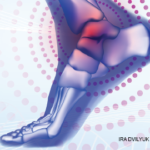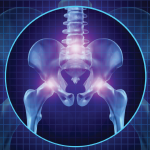BOSTON—Most people give little thought to how they walk, but patients with arthritis who have joint problems may face significant challenges in maintaining proper walking techniques.
There are a number of both simple and old-fashioned as well as high-tech ways to analyze the gait of patients who have pain during walking, according to a pair of speakers at the ACR/ARHP Annual Scientific Meeting in Boston last November in a session called “Gait Analysis: Hip, Knee, and Foot Effects on Gait and How to Assess Them.”
“Gait involves everything from our heads to our toes,” says Carol Oatis, PT, PhD, professor of physical therapy at Arcadia University in Glenside, Pa. “Gait is purposeful.” Physicians can offer strategies that will not only help patients walk where they need to go, but will also leave them with enough energy to complete their tasks and make the return trip.
Gait, Piece by Piece
Gait is split into two main phases: swing and stance. During the swing phase, the body moves a leg forward in anticipation of planting that leg to support the other leg’s upcoming swing phase. In the stance phase, one or both legs must support the entire weight of the body. There is a brief period of double support—where both legs share support of the body—at two points during each gait cycle.
The stance phase absorbs the impact shock from the body’s weight hitting the ground. It is not enough to merely keep the body upright in this phase, because the legs must also be positioning themselves to move forward in the next cycle of gait, says K. Douglas Gross, ScD, MPT, a research technologist in the clinical epidemiology research and training unit at Boston University. During stance, the heel is the first part of the leg to make contact with the ground, followed by the rest of the foot. As the body propels itself forward, the heel pushes off before the toe leaves the ground in anticipation of the next step.
Challenges that can impair the stance phase include problems in lower extremity strength, coordination, motor control, balance, and joint mobility and alignment. When a patient complains of pain when walking, it is important to determine at what phase of gait the problem arises, says Dr, Oatis. The problem could occur when the foot is hitting the ground and absorbing shock, or when the foot is pushing off the ground as momentum is transferred.
During the swing phase, the swing foot must clear the ground and land in a position where it will not trip the next swing foot. If the swing foot moves too far forward, creating a wide stance, it can hinder the proper transfer of momentum, says Dr. Oatis. Challenges faced during the swing phase include strength problems, coordination issues, trouble placing the foot in good position, and joint mobility issues.
The Pain Factor
When pain comes into play, it can affect walking speed, which in turn forces people to expend more energy. “The caloric cost of gait is minimized when we walk at our free speed,” says Dr. Oatis. “If we walk faster or slower, then we expend more energy.”
During the swing phase, there is little activity in any of the leg muscles. Most of the movement relies on energy transfer from the muscles in the hip to the knee and from the ankle muscles to the knee. Muscle movements in the hip and ankle are responsible for propelling the knee, which is slightly flexed, through the swing phase of each step. As a result, even patients with healthy knees may experience walking problems if they have hip or ankle problems. In walking, the knee is relatively passive.
Despite the knee’s relatively passive role in gait, stiffness in this joint can still impair walking speed during the swing phase. “Even if all the muscles are working,” says Dr. Oatis, “if the knee joint is stiff, this energy transfer becomes compromised because the knee isn’t freely [moving].”
When physicians or other health professionals examine a patient’s gait, they should not simply focus on the problem joint. Hip and ankle problems also play a prominent role in gait disturbance. When watching a patient walk, the health professional may notice too little or too much pronation of the foot, which normally turns inward during gait. For patients with too much pronation, there are orthopedic shoes that can control excessive motion. Underpronation, which is also known as supination, can be helped with special shoes or by adding extra cushioning to existing shoes.
Patients in pain tend to alter their gait in the stance phase to lessen the load on weight-bearing joints. In some cases, patients may change their line of gravity by leaning to one side during their stride. In other circumstances, they may adjust the timing of their gait or walk more slowly to lessen the burden on a painful joint. While slow walking speed and exaggerated leans may be easy to spot, it can be difficult to spot more subtle problems that can hinder a patient’s walking ability, says Gross.
Tools for Gait Analysis
One high-tech solution for gait analysis is an instrumented walkway. The patient is asked to walk across a special mat that is equipped with sensors to detect the length and timing of steps, toe and heel position at various points of gait, and time spent in single or double support. Analyzing these data can be easier than trying to watch for all the various factors that come into play for gait, says Gross.
Another technological trick is to provide patients with smart activity monitors, which are microprocessor devices worn on the waist. The devices are able to record information similar to that given by the instrumented walkway, but can also show how much time patients spend walking, running, or climbing stairs.
For health professionals who may not have access to such devices, there are more traditional ways to analyze gait. Physicians can ask patients to try walking in different positions—such as leaning a certain way or changing the position of their foot—to see how gait alters. Other ways to change gait include changing footwear, wearing braces, placing tape around the ankle, and using assistive devices, such as canes or walkers.
Physical therapists can help teach patients how to alter their gait by changing the timing of their steps, the size of each step, or the position of a foot when pushing off the toes, among other things, says Gross. In some cases, correcting a patient’s gait problems and pain can be as simple as changing footwear—for example, not wearing high heels as frequently.
Greg Lavine is a freelance journalist based in Maryland.

